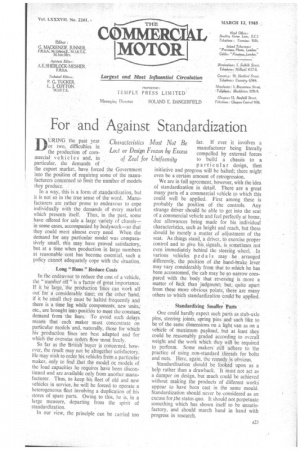For and Against Standardization
Page 23

If you've noticed an error in this article please click here to report it so we can fix it.
DURING the past year or two, difficulties in Characteristics Must Not Be production o c Lost or Design Frozen by Excess thef corn tnercial vehicles and in , of Zeal for Uniformity particular, the demands of the export market, have forced the Government into the position of requiring some ot the manufacturers concerned tO limit the number of models they produce. In a way, this is a form of standardization, but it iS not so in the true sense of the word. Manufacturers are rather prone to endeavour to cope individually with the demands of every, market which presents itself. Thus, in the past, some have offered for sale a large variety of chassis-in some cases, accompanied by bodywork—so that they could meet almost every need. When the demand for any particular model was comparatively small, this may have proved satisfactory, but at a time when production in large numbers at reasonable cost has become essential, such a policy cannot adequately cope with the situation.
Long " RIMS " Rednce Costs In the endeavour to reduee the cost of a Vehicle, the "number off" is a factor of great importance.' If it be large, the production lines can work all out for a considerable time the other hand, if it be small they must be halted frequently and there is a time lag while components, new units,' etc., are brought intopositiOn 1.0-Ineet the constatit. demand from the lines: To avoid such delays means that each maker must concentrate on particular models and, naturally, those for -which his production lines are best adapted and 'for which the overseas Order's flow most freely. So far as the 13ritish' buyer is eoncertied, howeve.r, the result may not be altogether satisfactory. He May wish to Order his vehicles from a particular maker, only to find that the model ot Models of the load capacities he requires have been diScon tinned and are available only from another. manufacturer. Thus, to keep his fleet of old and new vehicles in service, he will be forced to operate a heterogeneous fleet involving a duplication of his stores of spare parts. Owing to this, he is, in a large measure, departing from the spirit of standardization.
In our view, the principle can be carried too far. If ever it involves a manufacturer being literally compelled by external forces to build a chassis to a p a rt icular design, then initiative and progress will be halted; there might even be a certain amount of retrogression.
We are in full agreement, however, with the idea of standardization in detail. There are a great many parts of a commercial vehicle to which this could well be applied. First among these is probably the position of the controls. Any strange driver should be able to get into the seat of a commercial vehicle and feel perfectly at home, due allowances being made for his individual characteristics, such as height and reach, but these should be Merely a matter of adjustment of the seat: As things stand, -a driver, to exercise proper Control and to give his signals,. is sometimes not even immediately behind the steering wheel. In various vehicles pedals may be arranged differently, the position of the liand-brake lever may vary considerably from that towhich he has been accustomed, the cab 'may be so narrow compared with the body that reversing is.. more a matter of hick than judgment; but,' qUite apart from these more obvious points; there are many others to which standardization ;could be applied.
Standardizing Smatter farts One could hardly expect such parts as stub-axle pins, steering joints, spring pins and' such like to be of the same dimensions on a light van as on a vehicle of maximum payload, but at least they could be reasonably graded according to overall weight and the work which they will be required to perfortn. Some makers still adhere to the practice of using non-standard threads for bolts and nuts. Here, again, the remedy is obvious.
Standardization should be looked upon as a help rather than a drawback. It must not act as a damper on design, but much could be achieved without making the products of different works' appear to have been cast in the same mould. Standardization should never be .considered as an excuse forithe status quo. It should not perpetuate something which has shown itself to be unsatisfactory, anti should march hand in hand with progress in research.


















































































